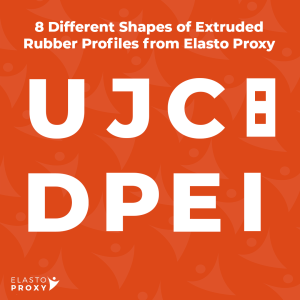Solid Profiles
Solid profiles are rubber extrusions that provide dimensional stability, design flexibility, and high tensile strength. They have a fixed cross-sectional shape but come in different shapes and sizes. Solid rubber profiles are harder and more resistant to compression than sponge profiles. However, both types of industrial rubber products are available in silicone, neoprene, EPDM, nitrile, and TPE.
ES08-525-N70
ES08-525-N70
More InformationES12-188-P80T1
ES12-188-P80T1
More InformationES12-189-P80T1
ES12-189-P80T1
More InformationES14-001-S60B
ES14-001-S60B
More InformationES14-125-C70
ES14-125-C70
More InformationES14-475-S60
ES14-475-S60
More InformationES18-067-P90
ES18-067-P90
More InformationES20-006-E60
ES20-006-E60
More InformationES20-055-E70
ES20-055-E70
More InformationES20-092-E70
ES20-092-E70
More InformationES26-187-21-E60T1
ES26-187-21-E60T1
More InformationES32-007-E70
ES32-007-E70
More InformationES32-062-E70
ES32-062-E70
More InformationES32-117-E70
ES32-117-E70
More InformationES32-123-N70
ES32-123-N70
More InformationSolid Rubber Profile Materials
Solid silicone profiles can withstand temperature extremes and are suitable for applications ranging from refrigerator gaskets and freezer seals to oven door seals. Solid silicone extrusions also good for high-temperature gaskets. Solid neoprene profiles offer good resistance to heat, oil, and weathering.
Solid EPDM profiles offer outstanding heat, ozone, and weather resistance, good steam resistance, and excellent electrical insulation. They come in in different densities, too.
Solid nitrile profiles provide excellent resistance to oils, solvents, and fuels. They also offer good abrasion resistance, good impermeability to gas, and good resilience to temperature extremes. Extruded rubber in nitrile is also referred to as Buna-N, a copolymer of butadiene and acrylonitrile.
Solid TPE profiles are made of thermoplastic elastomers, a group of rubber-like materials that combine the processing strengths of thermoplastics with the best qualities of thermoset rubbers. These thermoplastic rubbers have a higher material cost than other rubber materials. Solid TPE profiles can be cost-effective for small runs, however, because thermoplastic elastomers cure right away.
Solid Rubber Profile Specifications
In addition to compound selection and durometer (hardness), solid rubber profiles need are specified by part shape or cross-section. Types include rubber bumpers, c-channels, e-strips, glazing seals, j-seals, p-strips, quad, square and round cords, tubing, u-channels, rubber strips, locking and self-locking channels and zipper strips.
Rubber Extrusion
Rubber extrusion is a manufacturing process that creates stock materials or profiles with a fixed cross-section such as a U-shaped channel. First, uncured elastomers are pushed or drawn through a specialized metal tool called a die. Later, the rubber compound is cured through vulcanization, a chemical conversion process that uses heat and sulfur to impart durability and improve mechanical properties.
Rubber extrusion is used with many different types of elastomers, and this rubber manufacturing method supports complex cross-sectional profiles with an excellent surface finish. Because extrusion mixes and blends the raw materials, the cured rubber offers consistent strength and a uniform appearance along the length of the profile. Standards from the Rubber Manufacturers Association (RMA) define part tolerances based on physical dimensions and an RMA class of high precision, precision, or commercial.








